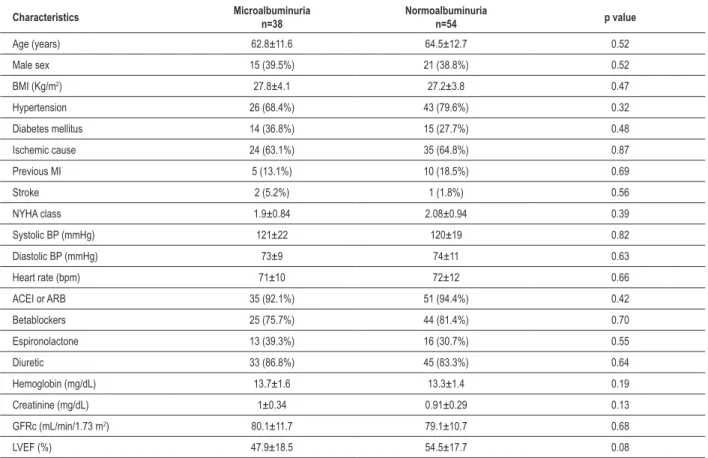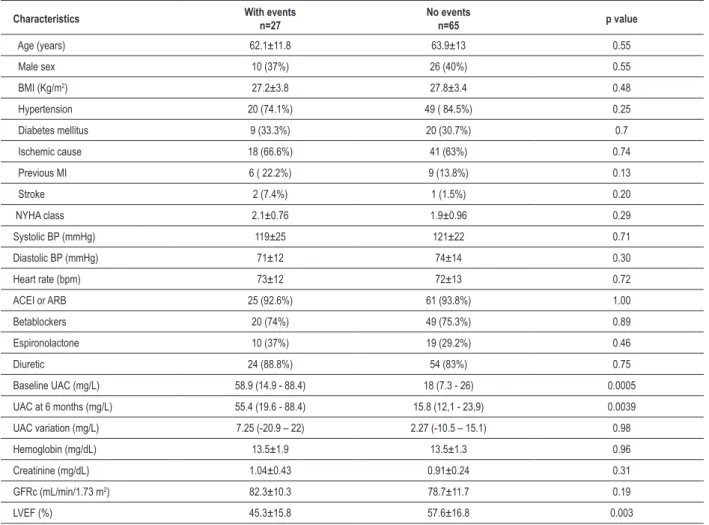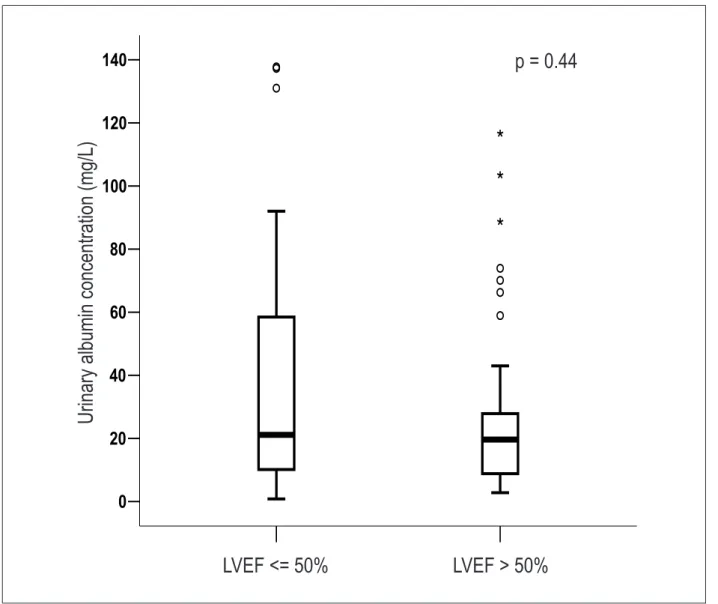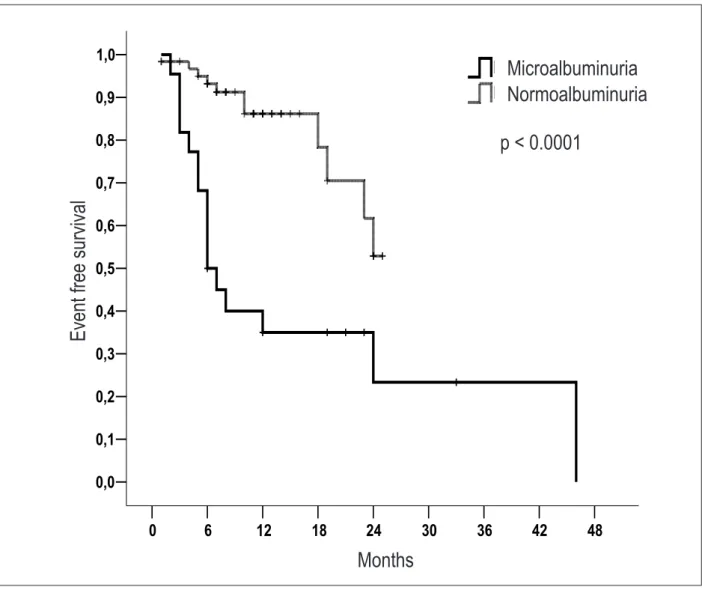Microalbuminuria is an independent prognostic marker in patients
with chronic heart failure
Humberto Villacorta, Paula de Vilhena Ferradaes, Evandro Tinoco Mesquita, Antônio Cláudio Lucas da Nóbrega
Universidade Federal Fluminense - Curso de Pós-Graduação em Ciências Cardiovasculares, Niterói, RJ, BrazilAbstract
Background:
Microalbuminuria has been described as a risk factor for progressive cardiovascular and renal diseases. Little is known about its prognostic value in patients (pts) with established heart failure (HF).Objective:
To assess the role of microalbuminuria as a prognostic marker in patients with chronic HF receiving standard medication.Methods:
From January 2008 through September 2009, 92 pts with chronic HF, were prospectively included. Mean age was 63.7±12.2 and 37 (40.7%) were male. Mean left ventricular ejection fraction (LVEF) was 52.5±17.5%. Pts under dialysis were excluded. Urinary albumin concentration (UAC) was determined in first morning spot sample of urine. Time to first event (HF hospitalization, emergency department visit for HF or cardiovascular death) was defined as endpoint. Mean follow-up was 11±6.1 months.Results:
At the time of inclusion in the study, 38 (41.3%) pts had microalbuminuria and no patient had overt albuminuria. Pts with microalbuminuria had lower left ventricular ejection fraction than the rest of the individuals (47.9±18.5 vs 54.5±17.7%, p=0.08). UAC was higher in patients with events (median 59.8 vs 18 mg/L, p=0.0005). Event-free survival was lower in pts with microalbuminuria as compared with normoalbuminuria (p<0.0001). Independent variables related to cardiac events were UAC (p<0.0001, hazard ratio=1.02, 95% CI=1.01 to 1.03 per 1-U increase of UAC), and previous myocardial infarction (p=0.025, HR=3.11, 95% CI=1.15 to 8.41).Conclusion:
Microalbuminuria is an independent prognostic marker in pts with chronic HF. Pts with microalbuminuria had a trend for lower LVEF. (Arq Bras Cardiol 2012;98(1):62-69)Keywords:
Albuminuria, heart failure, kidney diseases, prognosis.Mailing Address: Humberto Villacorta Junior •
Visconde de Silva, 154/402, Humaitá – 22271-090 – Rio de Janeiro – RJ, Brazil
E-mail: hvillacorta@cardiol.br, huvillacorta@globo.com
Manuscript received March 15, 2011; revised manuscript received June 13, 2011; accepted June 22, 2011.
in patients with established heart failure. Therefore, in this study, we assessed the prevalence and prognostic value of microalbuminuria in patients with stable chronic HF.
Methods
From January 2008 through September 2009, 92 patients with chronic HF, New York Heart Association (NYHA) functional class II to IV, were prospectively included. Patients were recruited from the Heart Failure Clinic of our Medical School Hospital. The diagnosis of HF was made on the basis of medical history, ongoing symptoms, and physical examination. In cases where the clinical diagnosis of HF was uncertain, B-type natriuretic peptide (BNP) was measured (Triage, Biosite Inc., San Diego, USA). Patients had been clinically stable for at least three months before the study and were on stable dose of angiotensin-converting enzyme (ACE) inhibitors or angiotensin receptor blockers (ARB), and a betablocker, unless contraindicated. In all off the patients, left ventricular ejection fraction (LVEF) was assessed by echocardiography using the Sympson method. Mean LVEF of the entire population was
52.5±17.5%. Patients with LVEF ≤50% were considered as
Introduction
Urinary albumin concentration (UAC) has been described as a risk factor for progressive cardiovascular and renal diseases1-4. The prevalence of microalbuminuria in patients
with hypertension and diabetes is 10% to 15% and 15% to 20%, respectively, which is higher than the prevalence in individuals from the general population in whom values of 6% to 8% have been described1,2. Increased albumin
excretion may be a marker of diffuse vascular injury, systemic inflammation, activation of the renin-angiotensin system, or early renal failure. Many of these abnormalities also occur in heart failure (HF). UAC has been associated with increased mortality not only in patients with diabetes and hypertension5-9, but also in the general population3,4. However,
having HF with reduced ejection fraction (HFREF) whereas patients with LVEF >50% were classified as HF with normal ejection fraction (HFNEF). Patients under dialysis were excluded. The study was approved by the ethics committee of our hospital and written informed consent was obtained from all patients.
Venous blood samples were taken and analysed at the local laboratory. Serum creatinine was measured using standard techniques. Serum creatinine, age, race, and gender were used to calculate glomerular filtration rate (GFRc) using the Modification of Diet in Renal Disease (MDRD) Study equation. First morning spot sample of urine was taken with the patient in the upright position and transported immediately to the laboratory. UAC was determined using a turbidimetric assay (Bioclin, Quibasa Química Básica, Belo Horizonte, Brazil) and microalbuminuria was defined as UAC 25-200 mg/L, according to the manufacturer’s instructions. UAC was determined at baseline and after 6 months.
Patients were followed-up at our HF clinic, with visits every three months. Mean follow-up was 11±6.1 months. The primary endpoint of the study was a composite outcome of death from a cardiovascular cause, admission for HF, emergency department visit for HF requiring intravenous diuretics. All endpoints were independently adjudicated.
Values are expressed as mean values ± SD or absolute number and percentage. Differences between group were investigated using unpaired t-test for independent samples or the chi-square test, when appropriate. Variables without Gaussian distribution are expressed as median and interquartil range and were analysed using Mann-Whitney test. Kaplan-Meyer event-free survival curves were constructed and compared using the log-rank test. Cox proportional hazards models were used to investigate the prospective association between UAC and events during follow-up.
Results
Mean age of the entire population was 63.6±12.2 years and 36 (39.1%) were male. Fifty eight (63%) patients were in NYHA functional class II, 26 (28.3%) in class III, and 8 (8.7%) in class IV. Median UAC was 21 mg/dL (interquartil range 9.72-50.95). Thirty eight (41.3%) patients had microalbuminuria and no patient had macroalbuminuria. Baseline characteristics of patients with and without microalbuminuria are shown in table 1. There were no differences regarding baseline characteristics between groups, except that patients with microalbuminuria had a trend for lower LVEF. However, median values of UAC were not different in patients with
LVEF ≤50% as compared with LVEF >50%, as shown in figure
Table 1 – Baseline characteristics of patients with and without microalbuminuria
Characteristics Microalbuminuria n=38
Normoalbuminuria
n=54 p value
Age (years) 62.8±11.6 64.5±12.7 0.52
Male sex 15 (39.5%) 21 (38.8%) 0.52
BMI (Kg/m2) 27.8±4.1 27.2±3.8 0.47
Hypertension 26 (68.4%) 43 (79.6%) 0.32
Diabetes mellitus 14 (36.8%) 15 (27.7%) 0.48
Ischemic cause 24 (63.1%) 35 (64.8%) 0.87
Previous MI 5 (13.1%) 10 (18.5%) 0.69
Stroke 2 (5.2%) 1 (1.8%) 0.56
NYHA class 1.9±0.84 2.08±0.94 0.39
Systolic BP (mmHg) 121±22 120±19 0.82
Diastolic BP (mmHg) 73±9 74±11 0.63
Heart rate (bpm) 71±10 72±12 0.66
ACEI or ARB 35 (92.1%) 51 (94.4%) 0.42
Betablockers 25 (75.7%) 44 (81.4%) 0.70
Espironolactone 13 (39.3%) 16 (30.7%) 0.55
Diuretic 33 (86.8%) 45 (83.3%) 0.64
Hemoglobin (mg/dL) 13.7±1.6 13.3±1.4 0.19
Creatinine (mg/dL) 1±0.34 0.91±0.29 0.13
GFRc (mL/min/1.73 m2) 80.1±11.7 79.1±10.7 0.68
LVEF (%) 47.9±18.5 54.5±17.7 0.08
Table 2 – Univariate comparison of patients with and without cardiovascular events during follow-up
Characteristics With eventsn=27 No eventsn=65 p value
Age (years) 62.1±11.8 63.9±13 0.55
Male sex 10 (37%) 26 (40%) 0.55
BMI (Kg/m2) 27.2±3.8 27.8±3.4 0.48
Hypertension 20 (74.1%) 49 ( 84.5%) 0.25
Diabetes mellitus 9 (33.3%) 20 (30.7%) 0.7
Ischemic cause 18 (66.6%) 41 (63%) 0.74
Previous MI 6 ( 22.2%) 9 (13.8%) 0.13
Stroke 2 (7.4%) 1 (1.5%) 0.20
NYHA class 2.1±0.76 1.9±0.96 0.29
Systolic BP (mmHg) 119±25 121±22 0.71
Diastolic BP (mmHg) 71±12 74±14 0.30
Heart rate (bpm) 73±12 72±13 0.72
ACEI or ARB 25 (92.6%) 61 (93.8%) 1.00
Betablockers 20 (74%) 49 (75.3%) 0.89
Espironolactone 10 (37%) 19 (29.2%) 0.46
Diuretic 24 (88.8%) 54 (83%) 0.75
Baseline UAC (mg/L) 58.9 (14.9 - 88.4) 18 (7.3 - 26) 0.0005
UAC at 6 months (mg/L) 55.4 (19.6 - 88.4) 15.8 (12,1 - 23,9) 0.0039
UAC variation (mg/L) 7.25 (-20.9 – 22) 2.27 (-10.5 – 15.1) 0.98
Hemoglobin (mg/dL) 13.5±1.9 13.5±1.3 0.96
Creatinine (mg/dL) 1.04±0.43 0.91±0.24 0.31
GFRc (mL/min/1.73 m2) 82.3±10.3 78.7±11.7 0.19
LVEF (%) 45.3±15.8 57.6±16.8 0.003
ACEI - angiotensin-converting enzyme inhibitors; ARB - angiotensin receptor blockers; BMI - body mass index; LVEF - left ventricular ejection fraction; MI - myocardial infarction; NYHA - New York Heart Association; UAC- urinary albumin concentration (median and interquartile range); GFRc- calculated glomerular iltration.
Table 3 – Independent predictors of cardiac events using Cox proportional hazards model
Variable Hazard ratio 95% CI p value
Microalbuminuria 1.02* 1.01 - 1.03 <0.0001
Previous MI 3.11 1.15 - 8.41 0.025
CI - conidence interval; MI - myocardial infarction.; * - Per 1-unit increase of urinary albumin concentration.
1. There was no correlation between UAC and serum creatinine (r = 0.06; p = 0.82). Likewise, no correlation was found between UAC and GFRc (r = -0.04; p = 0.84).
Twenty seven (29.3%) patients experienced an event during follow-up. Baseline UAC was higher in these patients, as shown in figure 2. However, no significant change in UAC overtime was observed in patients with or without events. Patients with events were also more likely to have a reduced LVEF. Univariate comparison of patients with and without events is shown in table 2. Event-free survival was lower in patients with microalbuminuria
as compared with normoalbuminuria, as shown in figure 3. Using Cox proportional hazards models, only microalbuminuria (continuous variable) and previous myocardial infarction were independent predictors of events (table 3).
Discussion
LVEF > 50%
LVEF <= 50%
140
120
100
80
60
40
20
0
U
ri
n
a
ry
a
lb
u
m
in
c
o
n
c
e
n
tr
a
ti
o
n
(
m
g
/L
)
p = 0.44
Figure 1 – Urinary albumin concentration in patients with heart failure and reduced left ventricular ejection fraction (LVEF ≤ 50%) versus normal ejection
fraction (LVEF>50%).
U
rin
ar
y a
lb
um
in
c
on
ce
ntr
ati
on
(
m
g/L
)
LVEF > 50%
LVEF <= 50%
p = 0.44
to have microalbuminuria. Interestingly, no differences regarding baseline characteristics were observed between patients with and without microalbuminuria suggesting that increased UAC was related to HF itself and not to comorbidities. Of note, UAC did not change significantly over time in either event or non event groups.
In this study, microalbuminuria was prevalent even in patients without hypertension or diabetes, suggesting that these abnormalities are not the cause of increased albumin excretion.
Although microalbuminuria has been for a long time described as a risk factor for developing HF and for cardiovascular mortality in hypertensive5,9 and diabetic
patients7, and also in the general population3,4, only
recently it has been studied in patients with established HF. Dipstick urine testing for proteinuria was performed at baseline in a subset of patients in the Studies of Left
Ventricular Dysfunction (SOLVD)10 and in the Survival and
Ventricular Enlargement (SAVE)11 trials. The prevalence of
proteinuria in these studies was 3% and 15%, respectively. By contrast, van de Wal et al12,using urinary albumin
to creatinine ratio, found higher prevalence, reporting that 32% of their patients had microalbuminuria. No significant differences were observed between patients with or without microalbuminuria, but a small number of patients were included. In this study, however, no data on outcomes were reported.
Only two recent studies assessed the prognostic value of microalbuminuria in patients with established HF. In the CHARM Study13, a clinical trial where candesartan was
no events
with events
140
120
100
80
60
40
20
0
U
ri
n
a
ry
a
lb
u
m
in
c
o
n
c
e
n
tr
a
ti
o
n
(
m
g
/L
)
p = 0.0005
Figure 2 – Urinary albumin concentration in patients with and without cardiac events during follow-up.
p = 0.0005
with events
U
rin
ar
y a
lb
um
in
c
on
ce
ntr
ati
on
(
m
g/L
)
no events
Cox regression analysis with 33 baseline characteristics as covariates. Candesartan did not reduce or prevent urinary albumin excretion. In another clinical trial, retrospective data on microalbuminuria was also reported. In the GISSI-HF, the prevalence of micro and macroalbuminuria was 20% and 5.4%, respectively14. There was a progressive,
significant increase inthe adjusted rate of mortality in the study population and in the subgroupof patients without diabetes or hypertension (hazardratio, 1.12; 95% CI, 1.05 to 1.18 per 1-U increase of log urinary albumin-to-creatinine ratio). Randomized treatments(n-3 polyunsaturated fatty acids or rosuvastatin) had no major impact on albumin excretion.
We found that microalbuminuria was an independent predictor of events when assessed as a continuous variable. This finding suggests that even an increasing UAC within the “normal” range is associated with increased risk of hospitalisation or death. The same finding was observed in the CHARM and in the GISSI-HF trials. Similar results
have been described in patients with stable coronary artery disease15.
In this study, microalbuminuria was prevalent even in patients without hypertension or diabetes, suggesting that these abnormalities are not the cause of increased albumin excretion. Likewise, no correlation was observed between UAC and creatinine or between UAC and GFRc. Additionally, UAC was a predictor of events regardless of renal function, as assessed by creatinine or GFRc, and LVEF.
The mechanisms underlying albuminuria in HF patients are not known. Renal abnormalities have been observed in patients with increased UAC16,17 and microalbuminuria has
been suggested as a marker of early renal damage. Although microalbuminuria has been observed in the presence of normal renal function as assessed by traditional tools, such as creatinine and estimated GFR12, it is possible that renal
48
42
36
30
24
18
12
6
0
Months
1,0
0,9
0,8
0,7
0,6
0,5
0,4
0,3
0,2
0,1
0,0
E
v
e
n
t
fr
e
e
s
u
rv
iv
a
l
Normoalbuminuria
Microalbuminuria
p < 0.0001
Figure 3 – Kaplan-Meyer event-free survival curves in patients with microalbuminuria versus normoalbuminuria.
E
ve
nt fr
ee
s
ur
vi
va
l
p < 0.0001
Microalbuminuria
Months
Normoalbuminuria
in diabetic patients with normal renal function (GFR>60 mL/min/1.73 m2) UAC was significantly correlated with
cystatin C, a sensitive marker of renal failure, both in patients with normoalbuminuria or microalbuminuria. On the other hand, it was not correlated either with serum creatinine or calculated creatinine clearance18. In another
study, urinary neuthrophile gelatinase-associated lipocalin (NGAL), another early marker of tubular damage, was shown to be high in patients with HF and paralleled the increases in UAC19.The relationship of UAC with these
markers of renal failure needs to be defined in prospective follow-up studies.
Another possible hypothesis is that microalbuminuria may be related to subclinical congestion. In chronic HF, venous congestion may be absent even in the presence of high filling pressures20. Patients with HF frequently are
readmitted to the hospital after an index hospitalization and unrecognized congestion has been implicated21. As
a matter of fact, central venous pressure was found to
be more important than cardiac index as a predictor of death in a broad population of patients with cardiovascular disease, including HF22. Venous congestion has also been
related to renal failure in patients with HF22,23. Therefore,
microalbuminuria may be a marker of early renal failure and preclinical congestion.
Generalized endothelial dysfunction has also been implicated in the genesis of albuminuria12,24,25. Patients
with HF have abnormal endothelial function and this may explain, at least in part, the high prevalence of microalbuminuria in HF.
Some limitations of this study must be addressed. First, this is a small, single center study. Therefore, our data need to be validated in larger prospective studies. Secondly, we did not measure important biomarkers of renal function, such as cystatin C and NGAL. BNP was measured in a small subgroup of patients, which limited statistical analysis.
prognosis in stable HF patients, using a simple and cheap method that can be easily used in daily clinical practice. Studies in a large population addressing the natural course of microalbuminuria in chronic HF and the potential for treatment target are warranted.
Conclusion
We found that microalbuminuria is common in pts with chronic HF despite optimal treatment and is independently related to prognosis. Pts with microalbuminuria in this setting have a trend for lower LVEF.
Potential Conflict of Interest
No potential conflict of interest relevant to this article was reported.
Sources of Funding
There were no external funding sources for this study.
Study Association
This article is part of the thesis of master submitted by Paula de Vilhena Ferradaes, from Universidade Federal Fluminense.
References
1. Garg AX, Kiberd BA, Clark WF, Haynes RB, Clase CM. Albuminuria and renal insufficiency prevalence guides population screening: results from the NHANES III. Kidney Int. 2002;61(6):2165-75.
2. Hillege HL, Janssen WM, Bak AA, Diercks GF, Grobbee DE, Crijns HJ, et al. Microalbuminuria is common, also in a nondiabetic, nonhypertensive population, and an independent indicator of cardiovascular risk factor and cardiovascular morbidity. J Intern Med. 2001;249(6):519-26.
3. Arnlöv J, Evans JC, Meigs JB, Wang TJ, Fox CS, Levy D, et al. Low-grade albuminuria and incidence of cardiovascular disease events in nonhypertensive and nondiabetic individuals: The Framingham Heart Study. Circulation. 2005;112(7):969-75.
4. Diercks GF, van Boven AJ, Hillege HL, Janssen WN, Kors JA, de Jong PE, et al. Microalbuminuria is independently associated with ischaemic electrocardiographic abnormalities in a large non-diabetic population: The PREVEND (Prevention of REnal and Vascular ENdstage Disease) Study. Eur Heart J. 2000;21(23):1922-7.
5. Agewall S, Wikstrand J, Ljungman S, Fagerberg B. Usefulness of microalbuminuria in predicting cardiovascular mortality in treated hypertensive men with and without diabetes mellitus: Risk Factor Intervention Study Group. Am J Cardiol. 1997;80(2):164-9.
6. Brantsma AH, Bakker SJ, Hillege HL, de Zeeuw D, de Jong PE, Gansevoort RT. Cardiovascular and renal outcome in subjects with K/DOQI stage 1-3 chronic kidney disease. Nephrol Dial Transplant. 2008;23(12):3851-8.
7. Gerstein HC, Mann JF, Yi Q, Zinman B, Dinneen SF, Hoogwerf B, et al. Albuminuria and risk of cardiovascular events, death, and heart failure in diabetic and nondiabetic individuals. JAMA. 2001;286(4):421-6.
8. Hemmelgarn BR, Manns BJ, Lloyd A, James MT, Klarenbach S, Quinn RR, et al. Relation between kidney function, proteinuria, and adverse outcomes. JAMA. 2010;303(5):423-9.
9. Klausen KP, Scharling H, Jensen G, Jensen JS. New deinition of microalbuminuria
in hypertensive subjects: association with incident coronary heart disease and death. Hypertension. 2005;46(1):33-7.
10. Capes SE, Gerstein HC, Negassa A, Yusuf S. Enalapril prevents clinical proteinuria in diabetic patients with low ejection fraction. Diabetes Care. 2000;23(3):377-80.
11. Jose P, Tomson C, Skali H, Rouleau J, Braunwald E, Arnold JM, et al. Influence of proteinuria on cardiovascular risk and response to angiotensin-converting enzyme inhibition after myocardial infarction. J Am Coll Cardiol. 2006;47(8):1725-7.
12. van de Wal RMA, Asselbergs FW, Plokker HWT, Smilde TDJ, Lok D, van Veldhuisen DJ, et al. High prevalence of microalbuminuria in chronic heart failure patients. J Card Fail. 2005;11(8):602-6.
13. Jackson CE, Solomon SD, Gerstein HC, Zetterstrand S, Olofsson B, Michelson EL, et al. Albuminuria in chronic heart failure: prevalence and prognostic importance. Lancet. 2009;374(9689):543-50.
14. Masson S, Latini R, Milani V, Moretti L, Rossi MG, Carbonieri E, et al. Prevalence and prognostic value of elevated urinary albumin excretion in patients with chronic heart failure: data from the GISSI-Heart Failure Trial. Circ Heart Fail. 2010;31):65-72.
15. Solomon SD, Lin J, Solomon CG, Jablonski KA, Rice MM, Steffes M, et al. Influence of albuminuria on cardiovascular risk in patients with stable coronary artery disease. Circulation. 2007;116(23):2687-93.
16. Carrie BJ, Hilberman M, Schroeder JS, Myers BD. Albuminuria and the permselective properties of the glomerulus in cardiac failure. Kidney Int. 1980;17(4):507-14.
17. Pinto-Sietsma SJ, Janssen WM, Hillege HL, Navis G, de Zeeuw D, de Jong PE. Urinary albumin excretion is associated with renal function abnormalities in a nondiabetic population. J Am Soc Nephrol. 2000;11(10):1882-8.
18. Kravaritou M, Thanopoulou A, Karamanos B, Kofinis A, Noutsou M, Spanou E, et al. Evidence that even “normal” albuminuria may denote incipient GFR reduction in patients with type 2 diabetes mellitus. Diabetes Res Clin Pract. 2009;85(3):317-21.
19. Damman K, van Veldhuisen DJ, Navis G, Voors AA, Hillege HL. Urinary neuthrophile gelatinase-associated lipocalin (NGAL), a marker of tubular damage is increased in patients with chronic heart failure. Eur J Heart Fail. 2008;10(10):997-1000.
20. Bocchi EA, Marcondes-Braga FG, Ayub-Ferreira SM, Rohde LE, Oliveira WA, Almeida DR, et al.; Sociedade Brasileira de Cardiologia. III Diretriz brasileira de insuficiência cardíaca crônica. Arq Bras Cardiol. 2009;92(1 supl.1):3-70.
21. Gheorghiade M, Filippatos G, De Luca L, Burnett J. Congestion in acute heart failure syndromes: an essential target of evaluation and treatment. Am J Med. 2006;119 (12 Suppl 1):S3-S10.
22. Damman K, van Deursen VM, Navis G, Voors AA, van Veldhuisen DJ, Hillege HL. Increased central venous pressure is associated with impaired renal function and mortality in a broad spectrum of patients with cardiovascular disease. J Am Coll Cardiol. 2009;53(7):582-8.
23. Mullens W, Abrahams Z, Francis GS, Sokos G, Taylor DO, Starling RC, et al. Importance of venous congestion for worsening of renal function in advanced heart failure. J Am Coll Cardiol. 2009;53(7):589-96.
24. Giannattasio C, Achilli F, Grappiolo A, Failla M, Meles E, Gentile G, et al. Radial artery-flow mediated dilatation in heart failure patients: effects of pharmacological and nonpharmacological treatment. Hypertension. 2001;38(6):1451-5.




